27.12.2023
The City as Orchestra, Language, Ritual. On the Performative Character of Chrysanthi Koumianaki’s Work.
Εικαστικες Τεχνες
Γλώσσα πρωτότυπου κειμένου: Αγγλικά
Text by Danai Giannoglou
Copy edited by EG Figure of Speech (Geli Mademli & Eleanna Papathanasiadi)
When I first told Chrysanthi Koumianaki that I thought she was a performance artist, she laughed. That was the beginning of an intensely interesting ongoing conversation we’ve been having for the past few months, during and after her solo project RSVP, which I curated in September 2022 at the B. & M. Theocharakis Foundation in Athens as part of the THF Raw exhibition series. “I direct events, I orchestrate them,” she keeps telling me, and even though I agree with her that she is most probably not a performer herself, I keep thinking that her practice expands the boundaries and the terminology of performance art.
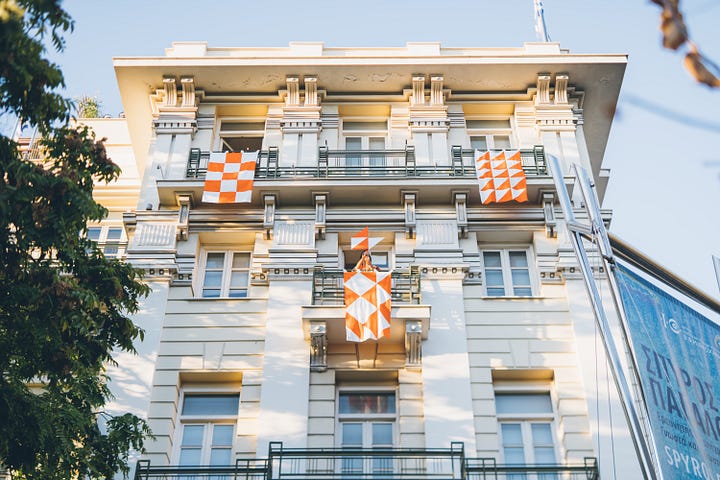
RSVP, which for me is the starting point of all these thoughts around Koumianaki’s work, encapsulates many different aspects of her practice; a performance enacted by the staff of the Theocharakis Foundation responding to the daily ritual of the presidential guard (Evzones in Greek), a stage and a backstage whose essence depend on where the viewer is standing and what they are looking for, a series of sculptures that function as potential and actual props, an invented code, and a careful, profound, and humorous observation of the elements that surround the work within and outside the institution.
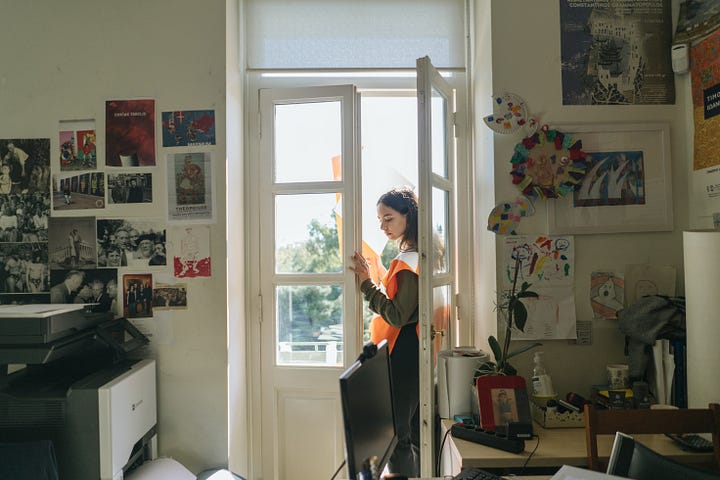
Performance - or orchestrated events - were not always part of Koumianaki’s artistic vernacular. For her solo exhibition Chroachym (2017), curated by locus athens (Maria-Thalia Carras and Olga Hatzidaki) at the MENTIS Center for the Preservation of Traditional Textile Techniques Athens (Benaki Museum), it is the first time that she asks performers to follow a set of instructions she creates. For this project, Pavlina Andriopoulou and Yiota Alexiou were asked to choreographically interpret a score drafted by Koumianaki drawing inspiration from the mechanical movement of the textile machines found at MENTIS. These choreographies were performed, filmed, and presented in the form of videos alongside sculptures.
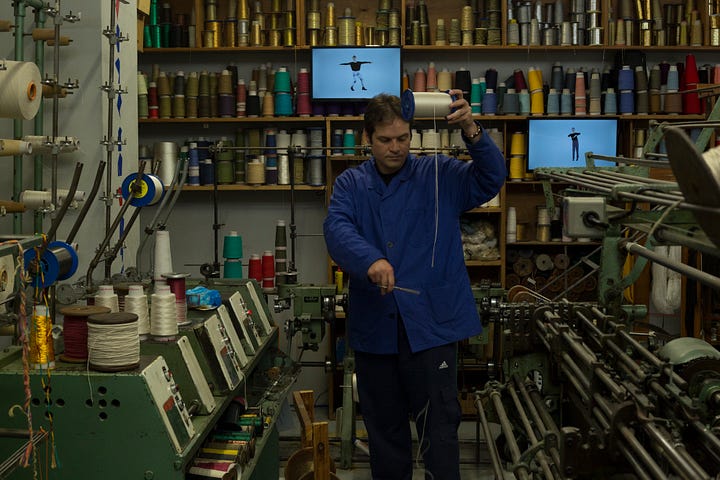
From that moment onwards, Koumianaki has been incorporating more and more performative techniques in her practice. In Statues that don’t move, don’t speak, don’t laugh, a group show curated by Galini Notti in 2020, it is the first time the performance unravels in the physical space. In the middle of a neighborhood basketball court and park in Patissia, actress Eva Vlassopoulos was posing as a live monument on a daily basis, wearing a uniform covered in transcribed graffiti tags.
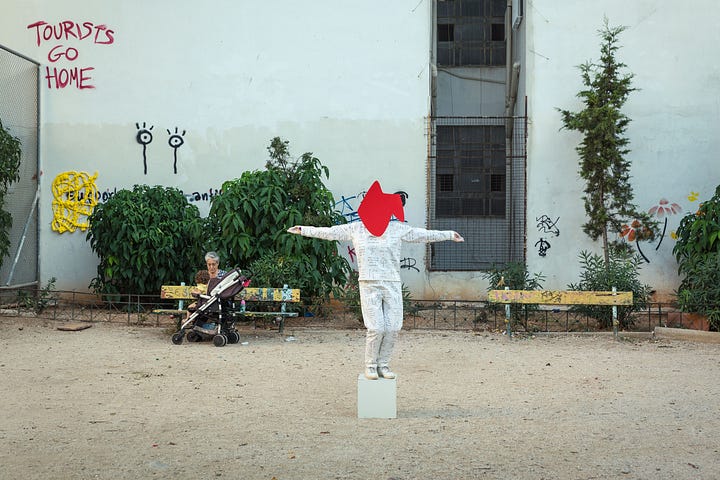
Koumianaki’s approach to performance is indeed not always evident, but remains definitely open-ended. She understands most things as performances but her gestures to highlight that are not always performances themselves. A keystone that often appears in her practice is the creation of interactive sculptures that, through a language of translation and deduction, allude to elements of the Athenian public space. However, the public space she is interested in is the one that has already undergone interventions which make the existence of citizens visible within the ‘set’ they inhabit. In Equilibrists (2016), a group show curated by Helga Christoffersen and Gary Carrion-Murayari and organized by DESTE Foundation, Athens, and New Museum, New York, in collaboration with the Benaki Museum, Koumianaki creates sculptures inspired by the broken railings in the streets of Athens, as well as the handles in public transportation vehicles. At the same time, a mural behind the sculptures serves as a score for the visitors, prompting them to interact with them and reflect on different choreographical and bodily uses of such elements commonly found in the public space.
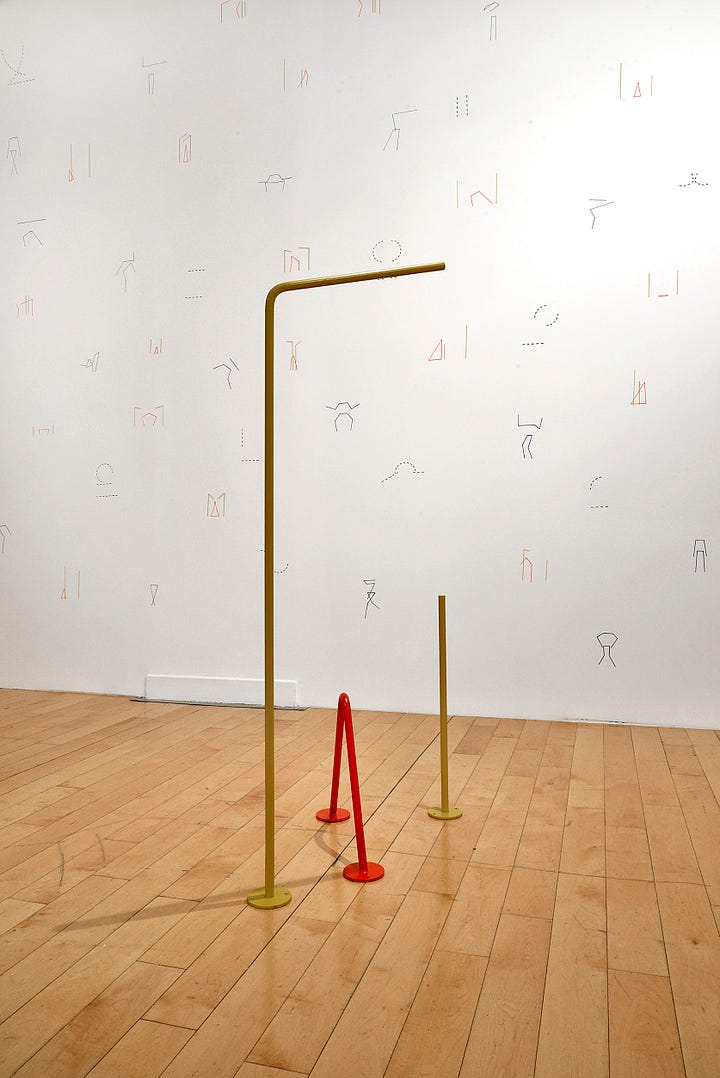
For her solo exhibition They Keep Chewing Walls (2018), curated by Els Silvrants-Barclay and Pieternel Vermoortel at Netwerk, Aalst, Belgium, she follows a similar pattern. This time she creates terrazzo-like surfaces on wheels, referring to the pavements and the chewed gums that people throw on them without much thought, as well as curtains with magnified graffiti symbols and poles like the ones carrying traffic lights and signs, always full of stickers and ads. While she borrows the aesthetics of architectural tools such as mood-boards and renders, she is not using them to imagine an ideal city, but to map the existing one in its glorious reality. The ‘insignificant’ elements - the gum, the handles, the broken railings, the tags on the walls - interrupt the experience of the public space in the way it was ideally organized, and become landmarks. They are no longer ephemeral gestures: they create non-verbal vocabularies of disruption which attest to our presence in the city as performers. For Koumianaki, their existence and our co-existence with these elements has vivid similarities with our everyday ritualistic automatizations that become a universal language. Her practice distills this language and turns it into yet another code emphatically twisting the automatization into something pleasingly uncanny that you cannot overlook.
In later projects, such as her piece The Stage is Empty: Part I & Part II (2021), commissioned by NEON Organization for Culture and Development for the exhibition Portals, curated by Elina Kountouri and Madeleine Grynsztejn at the former Public Tobacco Factory in Athens, it is evident that Koumianaki keeps thinking about the living monuments, the use of public space, and our everyday dramaturgy. The first part of the work, which takes place in Kolonos Hill, consists of banners that map the life and activity of the hill in a codified language. The banners were hung throughout the park on existing pillars. The second part, which appears in the Kolonos open-air theater, “is a play realized exclusively through light,” as mentioned in the exhibition’s promotional material. With a light performance loaded with dramaturgical connotations, movement, and expression, Koumianaki leaves the stage seemingly ’empty’ for visitors and passers-by to witness or to be part of it. Scattered around, actors are performing in conversation with everything that is happening on- and offstage.
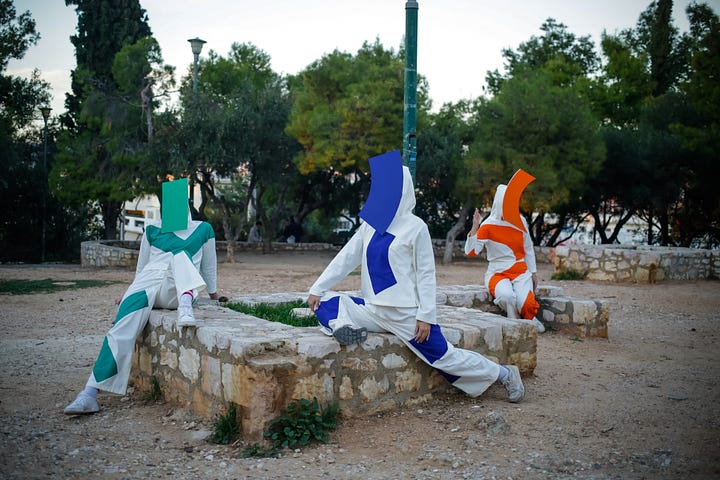
Koumianaki’s relationship to performance as a coherent recognizable language that touches upon recurrent subjects pertaining to the public space and urban environment might begin in 2016, with the exhibition Chroachym; however, it is clear that performative traces appear in her practice long before this. Her work I Love You, You Love Me (2013) might be a digital print, but it derives from a collective performance with Panos Papadopoulos and Albert Mayr. For this performance, Koumianaki had photographed her mouth making all the alphabet sounds and then used the photos to make collages that were “speaking words.” The ultimate goal was to develop a hybrid method of teaching Albert Mayr how to speak Greek. In 2019, in an act during which the performers remain hidden or in the backstage, she collaborates again with Papadopoulos and Mayr - this time in Petra Martinetz Gallery, Cologne.
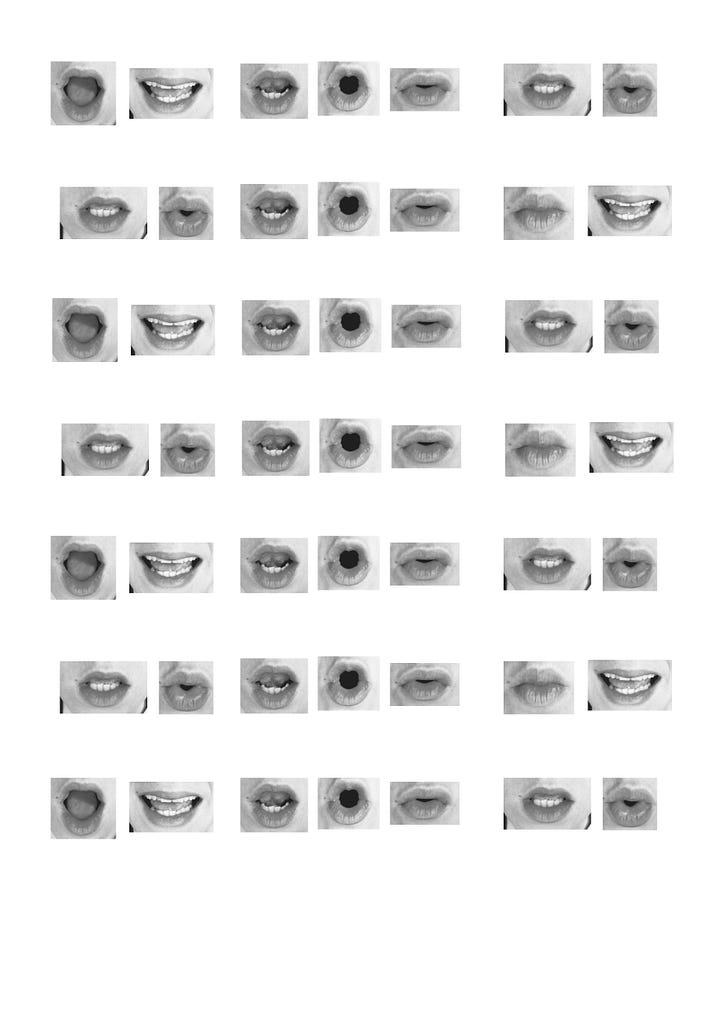
Last but not least, in 2017, together with architect Fanis Kafantaris, she created a map of public space disruptions in the Exarchia neighborhood; its “punctuation marks,” as she often calls them. Consecutively, the two of them brought together museum labels which they placed next to each one of these marks together with mediators that would interact with the audiences, guiding them through the neighborhood.
Koumianaki speaks in tongues, but her codes are far from hermetic. Their existence as wholes, as entities, provide sub-textual tools to access the works, as well as everyday routines unraveling through different prisms. While her language is not revealing, it is in its concealing that matters open up to interpretation.
—
“The City as Orchestra, Language, Ritual. On the Performative Character of Chrysanthi Koumianaki’s Work.” was written in April 2023 by Danai Giannoglou.
Chrysanthi Koumianaki (1985, Heraklion) is a visual artist who lives and works in Athens. In her practice she explores the idea of translation, creating symbolic systems, codings, alphabets that focus on non-verbal communication. She revises and tackles rules and methods of a universal visual language, creating new narratives that reflect different times. Her main work comprises installations that combine various media: prints, ephemeral drawings, videos, sound and metal structures. Her work has been shown in solo and group exhibitions in institutions, museums and galleries such as: Netwerk Aalst (2018), Kadist, Paris (2017); Benaki Museum, Athens (2016); DESTE Foundation for Contemporary Art, Athens (2016); Biennale of Contemporary Art of Thessaloniki (2015); Athens Biennale (2013) and National Museum of Contemporary Art, Athens (2013). Her work has been shown in institutions and museums, at Fondazione Prada (Milan, 2017) and at New Museum (New York, 2016) among others. Ιn 2012, together with Kosmas Nikolaou and Paky Vlassopoulou, she co-founded the artist-run space 3 137.She has been awarded the Stavros Niarchos Foundation Artist Fellowship by ARTWORKS (2018).
Danai Giannoglou (Athens, 1992) is an independent curator and writer based in Athens. She is the co-founder and curator of Enterprise Projects, a project space functioning independently and periodically since September 2015 in Athens, as well as the Editor of Enterprise Projects Journal, a publishing initiative by Enterprise Projects uploading newly commissioned theoretical and research essays. She has worked for public and private institutions in Athens and Paris. Between 2018–2019 Danai Giannoglou was the Exhibitions Archive Coordinator at DESTE Foundation for Contemporary Art. She has contributed texts in catalogues, publications and online art magazines and she has curated exhibitions in Greece and abroad. Giannoglou holds a BA in Theory and History of Art from the Athens School of Fine Arts and an MA in Cultural Management and Curating from Paris 1 Panthéon–Sorbonne University. She has been resident at Rupert, Lithuania in 2016 and at the 8th Gwangju Biennale International Curator Course, South Korea in 2018. She is a recipient of the Stavros Niarchos Foundation (SNF) Artist Fellowship Program (Curating) 2019/20 by ARTWORKS, as well as of Onassis AiR Emergency Fellowship 2019/20.



